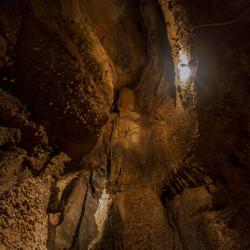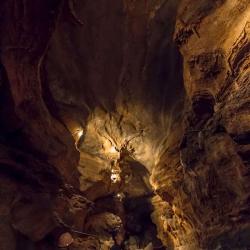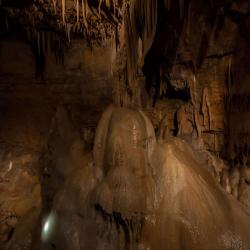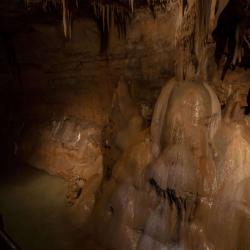Seneca Caverns in Riverton, West Virginia trip was planned to stay dry while it rained outside. We learned about these caves while looking at Seneca Rocks. Since we were headed there, we thought why not stop by a cave. Caves are always cool to see and explore. We didn't know but Pendleton County has over 100 known caves and is the most prolific area for caves in the entire United States. As part of the Appalachian Mountains, the valley is home to some of the oldest limestone on the east coast. It is because of this limestone, which is water soluble that they have so many caves. The funny part was when we arrived at Seneca Caverns in Riverton, West Virginia, it was not right at a mountain like I envisioned. So when we pulled up, I thought they were going to shuttle us to a nearby large mountain. We paid the $14 each for the tour, and they said the cave entrance was right outside the back door there. Looking around the property to my surprise, all I see is fields and woods on a little slope. This is NOT where you expect a cave at all.
The tour guide was a nice little local girl, who proceeded to tells us how to put on our hard hats for the adventure. Once we were suited up with our goofy hats, we were off to the caves. A little fence was there with a gate, and I am thinking there can't be a cave here....it doesn't look...cavey? Well our tour guide walked us down a set of small steps and opened a door....and Wahla!..there is a cave. We walked in and she turned on some lights and the adventure began. I love exploring in things like this. The tour guide gave us the "Don't touch until I tell you to touch" instructions speal. This was for good reason because these caves are very fragile places. You think it's made of rock, but if you touch a stalagmite, it can stop their growth over time. The tour guide did let us touch one that was already kind of dying due to no water in a certain area. The rocks look shiny like they are slippery, but it is not the least bit slippery. It felt a bit like snake skin. You think it's smooth, but it isn't. It felt like 300-400 grit sandpaper.
As our tour guide led us on the cave tour, she would stop and say the name of each formation and tell us a story of how it got named. I laughed and told her I think someone spent a little too much time in the cave if you know what I mean; she laughed. They had some crazy names for these formations in the caves. The funny part is if you looked at them, you can see why they named them what they did. She told us the cave was found by a German-American settler named Laven Teter who discovered the Seneca Caverns in 1742 while trying to find water to supply his livestock. She asked us if we would have gone down in here to find water; I said, "Probably not." This cave is a labyrinth of descents, going down almost 200+ feet. With each descent it looked even more amazing. The area becomes smaller and tighter too. Our guide, who was a little vertically challenged, said this path was a small man's revenge on tall people. Poor Steven had to duck non-stop as we got closer to the depths of the cave. I, on the other hand, had to hardly duck at all....sweet revenge."Take that, Tall Boy", I said laughing.
As our tour came to a close, we popped out the door into the woods onto a winding path taking us 25 yards back to a grassy knoll, over top of where we had just been... it was probably 110 yards maybe. As we walked on the lush green grassy lawn right over where we were 20 minutes ago, I marveled about the coolest cave I have seen cleverly hidden below. It makes you wonder.. what hidden curiosities are lurking beneath our feet that we don't even know it's there.

























